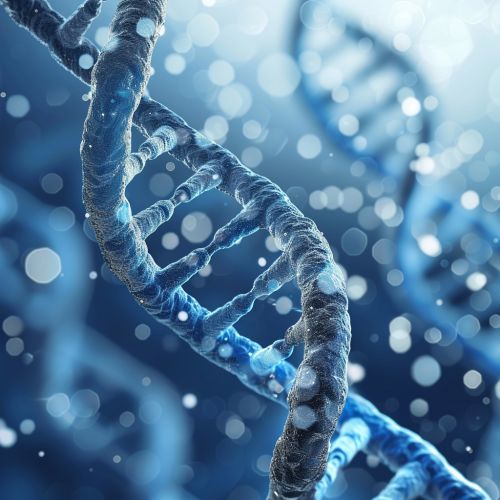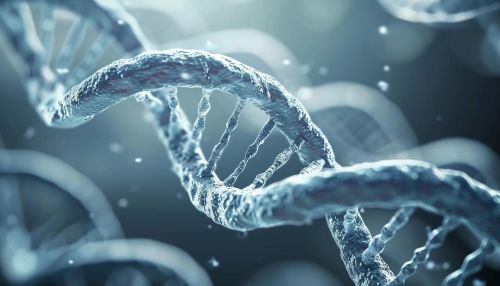Genetic inheritance: Difference between revisions
(Created page with "== Introduction == Genetic inheritance is the process by which genetic information is passed from parents to their offspring. This transmission of genetic material is fundamental to the continuity of biological traits and the diversity of life forms. The study of genetic inheritance encompasses various scientific disciplines, including genetics, molecular biology, and evolutionary biology. == Historical Background == The concept of genetic inheritance dates...") |
No edit summary |
||
| Line 82: | Line 82: | ||
* [[Bioinformatics]] | * [[Bioinformatics]] | ||
[[Image:Detail-93241.jpg|thumb|center|Double helix structure of DNA.|class=only_on_mobile]] | |||
[[Image:Detail-93242.jpg|thumb|center|Double helix structure of DNA.|class=only_on_desktop]] | |||
== References == | == References == | ||
Latest revision as of 04:54, 22 June 2024
Introduction
Genetic inheritance is the process by which genetic information is passed from parents to their offspring. This transmission of genetic material is fundamental to the continuity of biological traits and the diversity of life forms. The study of genetic inheritance encompasses various scientific disciplines, including genetics, molecular biology, and evolutionary biology.
Historical Background
The concept of genetic inheritance dates back to ancient times, but it was not until the 19th century that the mechanisms underlying inheritance were scientifically explored. Gregor Mendel, an Austrian monk, is often referred to as the father of modern genetics. His experiments with pea plants laid the foundation for the Mendelian inheritance principles, which describe how traits are inherited through discrete units known as genes.
Mendelian Inheritance
Mendelian inheritance refers to the patterns of inheritance that are characteristic of organisms that reproduce sexually. Mendel's laws include the Law of Segregation and the Law of Independent Assortment.
Law of Segregation
The Law of Segregation states that each individual has two alleles for each gene, one inherited from each parent. These alleles segregate during the formation of gametes, ensuring that each gamete carries only one allele for each gene.
Law of Independent Assortment
The Law of Independent Assortment posits that the alleles of different genes assort independently of one another during gamete formation. This principle explains the genetic variation observed in offspring.
Non-Mendelian Inheritance
While Mendelian inheritance provides a framework for understanding genetic inheritance, many traits do not follow these simple patterns. Non-Mendelian inheritance includes phenomena such as incomplete dominance, codominance, and polygenic inheritance.
Incomplete Dominance
In incomplete dominance, the phenotype of heterozygous individuals is intermediate between the phenotypes of homozygous individuals. For example, in certain flower species, a cross between red-flowered and white-flowered plants results in offspring with pink flowers.
Codominance
Codominance occurs when both alleles in a heterozygous individual are fully expressed, resulting in a phenotype that simultaneously displays traits from both alleles. An example of codominance is the ABO blood group system in humans.
Polygenic Inheritance
Polygenic inheritance involves multiple genes contributing to a single trait. These traits often exhibit continuous variation, such as height, skin color, and intelligence.
Molecular Basis of Inheritance
The molecular basis of inheritance lies in the structure and function of DNA (deoxyribonucleic acid). DNA is composed of nucleotides, which include a phosphate group, a sugar molecule, and a nitrogenous base. The sequence of these bases encodes genetic information.
DNA Replication
DNA replication is the process by which DNA makes a copy of itself during cell division. This process ensures that each daughter cell receives an identical set of genetic information. Key enzymes involved in DNA replication include DNA polymerase, helicase, and ligase.
Transcription and Translation
The flow of genetic information from DNA to protein involves two main processes: transcription and translation. During transcription, a segment of DNA is copied into messenger RNA (mRNA) by the enzyme RNA polymerase. Translation is the process by which the mRNA sequence is used to synthesize proteins, with the help of ribosomes and transfer RNA (tRNA).
Genetic Variation
Genetic variation is essential for the survival and evolution of species. It arises from mutations, genetic recombination, and gene flow.
Mutations
Mutations are changes in the DNA sequence that can occur spontaneously or be induced by environmental factors. They can be classified into different types, such as point mutations, insertions, deletions, and chromosomal rearrangements.
Genetic Recombination
Genetic recombination occurs during meiosis, the process of cell division that produces gametes. It involves the exchange of genetic material between homologous chromosomes, leading to new combinations of alleles.
Gene Flow
Gene flow is the transfer of genetic material between populations. It can occur through the movement of individuals or the exchange of gametes, contributing to genetic diversity.
Epigenetics
Epigenetics is the study of heritable changes in gene expression that do not involve alterations in the DNA sequence. Epigenetic modifications include DNA methylation, histone modification, and non-coding RNA molecules.
DNA Methylation
DNA methylation involves the addition of a methyl group to the DNA molecule, typically at cytosine bases. This modification can repress gene expression and is involved in processes such as genomic imprinting and X-chromosome inactivation.
Histone Modification
Histone proteins help package DNA into chromatin. Chemical modifications of histones, such as acetylation and methylation, can influence gene expression by altering chromatin structure.
Non-Coding RNA
Non-coding RNAs, including microRNAs and long non-coding RNAs, play roles in regulating gene expression at the post-transcriptional level.
Genetic Disorders
Genetic disorders are diseases caused by abnormalities in an individual's genetic material. They can be classified into single-gene disorders, chromosomal disorders, and complex disorders.
Single-Gene Disorders
Single-gene disorders are caused by mutations in a single gene. Examples include cystic fibrosis, sickle cell anemia, and Huntington's disease.
Chromosomal Disorders
Chromosomal disorders result from abnormalities in chromosome number or structure. Down syndrome, caused by an extra copy of chromosome 21, is a well-known chromosomal disorder.
Complex Disorders
Complex disorders involve multiple genetic and environmental factors. Examples include diabetes, heart disease, and schizophrenia.
Genetic Counseling
Genetic counseling is a process that helps individuals understand and adapt to the medical, psychological, and familial implications of genetic contributions to disease. It involves risk assessment, education, and support.
Ethical Considerations
The study and application of genetic inheritance raise various ethical issues, including concerns about genetic privacy, discrimination, and the potential for genetic engineering.
See Also


